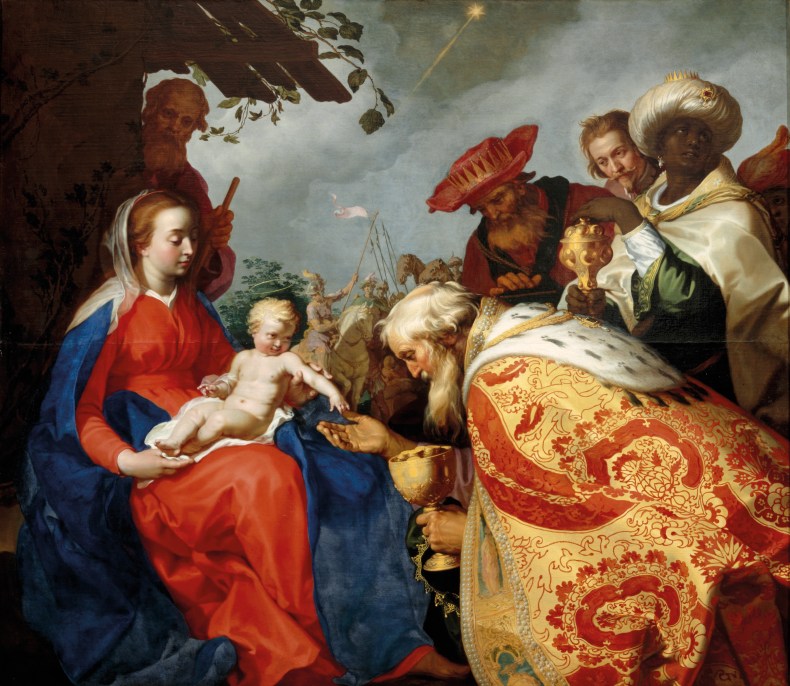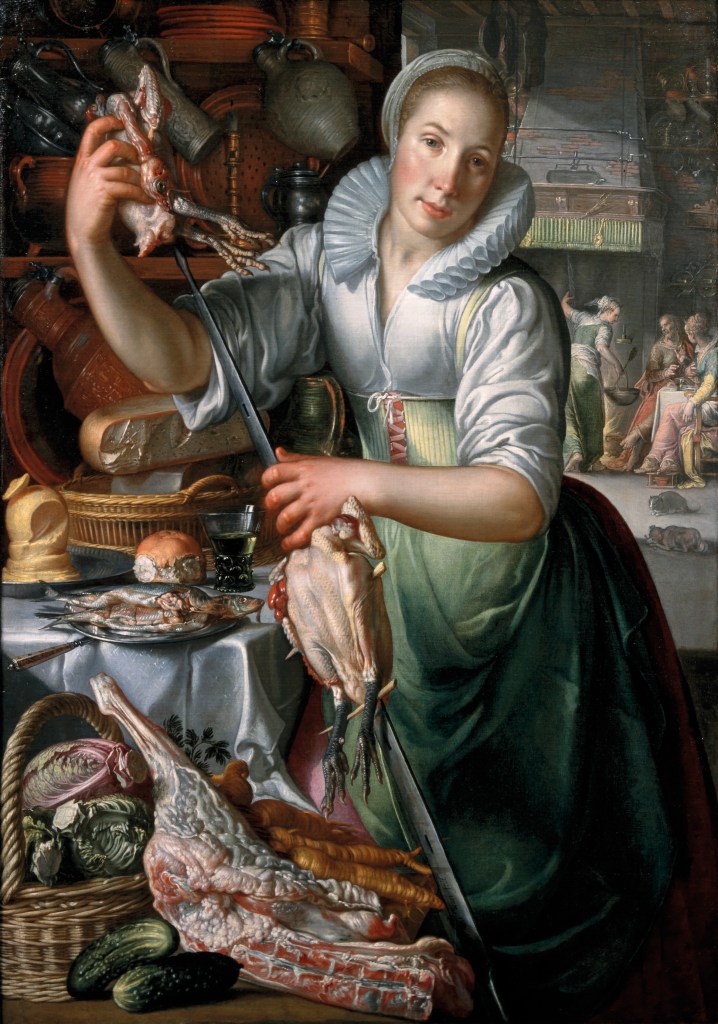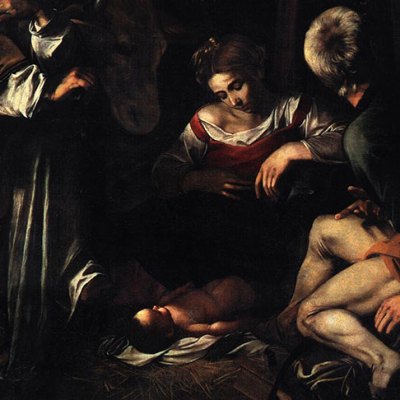Utrecht, a mere 35 kilometres south-east of Amsterdam, has been sitting firmly in its more glamorous neighbour’s shadow for centuries. It has had its moments in the sun but not for some time: Pope Adrian VI, the last non-Italian pope until John Paul II, was born in the city in 1459, and Europe gathered along its canals in 1713 for the Treaty of Utrecht, which brought an end to the War of the Spanish Succession. Mostly though it has left a light mark on history: as the French representative at the Treaty of Utrecht pointed out ungenerously to his hosts, the city – and the Dutch – had little active role to play in the negotiations, which were ‘De vous, chez vous, sans vous’ (concerning you, in your house, but without you).
The city has been something of an onlooker too in terms of Dutch art. In a country overstuffed with major artists Utrecht has produced relatively few – Antonis Mor and Jan van Scorel in the 16th century and Theo van Doesburg in the 20th are among its better-known sons. In the first half of the 17th century, however, Utrecht played a central role in the history of Western art. In the 1610s, a group of highly talented local artists – most notably Gerrit van Honthorst, Dirck van Baburen, Hendrick ter brugghen and Matthias Stom – travelled to Rome to study and were heavily influenced by the work they found there of the recently deceased Caravaggio, and on their return home they brought Caravaggism with them. It was the Utrecht Caravaggisti who were most responsible for the spread of tenebrist realism in northern European art.
The Rich Man and the Poor Lazarus (1625), Hendrick ter Brugghen. Centraal Museum, Utrecht

It is this group, the city’s great artistic claim to fame, that will be the focus of a major exhibition at Utrecht’s Centraal Museum, opening on 15 December (and later travelling to the Alte Pinakothek in Munich in April 2019). The museum hopes that ‘Utrecht, Caravaggio and Europe’, which has been four years in the planning, will give the institution the national and international visibility it has so far been lacking.
The show is also part of what its new artistic director, Bart Rutten, identifies as a desire to ‘embrace rootedness’. The Centraal Museum, which opened to the public in 1838, is the oldest municipal museum in the Netherlands and was inaugurated with the advertisement that it held a ‘Collection of Ancient Sculptures and other antiquities. Drawings and Paintings, mostly relating to the town of Utrecht’. Part of its ongoing brief is to celebrate Utrecht culture. ‘With all respect,’ says Rutten, ‘what does MoMA still have to do with the city of New York? It could really be anywhere. We want to remain grounded in the city.’
Rutten is alive to the danger of ignoring the permanent collection: ‘We are always re-looking at it,’ he says. ‘We need to harvest from it, find new perspectives and new forms of display.’ One of the things that is currently occupying him is what the museum should be collecting now to represent 20th- and 21st-century Utrecht. An energetic, affable and youthful 45-year-old, Rutten joined the museum in May 2017 after nine years at the Stedelijk Museum in Amsterdam, where he was head of collections. He has strong local links, having lived in Utrecht when he studied literature at the university from 1992. Indeed his first acquisition as director was a banner of the children’s character Miffy wearing the football shirt of FC Utrecht. The banner was made by the club’s supporters to mark the death of the cartoon rabbit’s creator, Dick Bruna, who lived and worked in the city.
A museum devoted solely to the Miffy character forms part of the Centraal Museum’s holdings (Bruna’s modest studio has been recreated up in the roof space) and is housed in a building which opened in 2006 immediately across the street. Its target audience may be two to six year olds but, as one of the staff commented drily, it could also be 22–24 year-old Japanese women.
Banner depicting Miffy in FC Utrecht, made by supporters to mark the death of Miffy’s creator Dick Bruna (2017), by Justin van den Eijnden, Tycho Oosterndorf and Jeroen Heisen. Centraal Museum, Utrecht. Photo: CMU/Ernst Moritz

Rutten arrived at the Centraal at a propitious time; 2016 saw the end of a three-year major refurbishment programme of the museum buildings; the Caravaggisti show was well into planning, or, as Rutten puts it, ‘A love baby delivered in my time – lucky me’; and visitor numbers for 2017 reached a record high at 318,000. Numbers though are not a fixation with him: ‘I’m not someone to say we need to grow to half a million visitors,’ because it is all about putting on exhibitions that are relevant to the city so, he suggests, there will be no Picasso or Matisse shows. ‘I don’t like the word “blockbuster”,’ Rutten says. ‘I want our visitors to be able to see the pictures without having to crawl over the heads of others.’ What the museum can do instead, he thinks, is ‘grow in visibility’.
The challenge for Rutten is how to square increased visibility with remaining Utrecht’s city museum. The way to do this, he thinks, is to ‘cook with local, national and international ingredients’. What this translates as is working with local artists, showing the civic collection imaginatively (the Centraal Museum is one of the few Dutch establishments to have kept its city history holdings rather than offloading them to a separate institution) and appealing to foreign visitors all at the same time. Ultimately Rutten wants his charge to be a ‘city museum of world class’.
The Adoration of the Magi (1624), Abraham Bloemaert. Centraal Museum, Utrecht

Rutten and the museum’s business director Marco Grob certainly have plenty to work with. The Centraal is a cabinet of curiosities encompassing both fine and applied arts and based around six main groupings: the 15,000 object city collection; the Gerrit Rietveld collection – the largest Rietveld holdings in the world, including, since 1987, the Rietveld Schröder House about a kilometre across the city, one of the gems of De Stijl architecture and a UNESCO world heritage site; a substantial and growing modern and contemporary art collection (the museum was exhibiting Marlene Dumas, for example, as long ago as 1984); a fashion collection dating back to 1917 when it was the first museum in the world to appoint a fashion curator; the Utrecht Caravaggisti paintings; and the Dick Bruna/Miffy collection.
The Centraal holds some 50,000 works, from Roman artefacts dating from the city’s foundation around 50 AD and ecclesiastical silver reflecting Utrecht’s defiant Catholicism to a rare portrait by the landscapist Jan Weenix of René Déscartes and mannerist paintings by Joachim Wtewael, a local flax merchant and town councillor. As well as coins, objets de vertu and a collection of 18th- and 19th-century dresses there is a Viking sword, accomplished baroque religious works by Abraham Bloemaert, a small cluster of Van Goghs and an early Mondrian. The museum, notes Rutten, has ‘a bit of everything’.
The Kitchen Maid (c. 1620–c. 1625) Joachim Wtewael. Centraal Museum, Utrecht

‘I like that we are a chameleon, and we don’t want to hide our eclectic identity but celebrate it,’ he says. He will need to take his visitors with him since looking at various comments boards, not everyone is a fan of this variety: ‘curious’, ‘interesting but…’, and ‘different’ being some of the observations. But for those who do want a mixture, visitors who come looking for, say, Honthorst or Miffy, will also be confronted by two of the Centraal’s prize possessions, the 17th-century doll’s house of Petronella de la Court, a perfect simulacrum of a patrician home filled with some 2,000 individual pieces, from miniature playing cards to the scullery maid’s mangle and, on a grander scale, the ‘Utrecht ship’, a large wooden cargo boat dating from 997 to 1030 that used to transport goods up and down the region’s canal and rivers which was dug up intact nearby in 1930: part of the basement wall of the museum had to be removed to fit it in and then rebuilt.
The museum is also blessed in that it has a very generous allocation of space. The main building is the former Agnes Convent which dates back to 1420 and has also served over the centuries as a factory, orphanage and a barracks. A wing built in 1920 houses the city collection and the voluminous stables to the rear of the old convent garden are a large, linear space for temporary exhibitions. The buildings, a bit of a warren, are linked together by glass passages and walk-throughs. There are 1,100 square metres to play with in all.
Although the museum has various shows lined up for 2018 (Erich Wichman, for example, a Utrecht-born one-eyed fascist, alcoholic modernist, and Jan Taminiau, a contemporary fashion designer), its gaze is already on the Caravaggisti show. There are financial reasons as well as artistic ones: the exhibition budget, says Rutten, is four to five times greater than usual and they need a minimum of 75,000–80,000 visitors over its three-month run just to cover costs. Money matters are the concern of the museum’s managing director Marco Grob and while the institution is largely funded by the city of Utrecht the exhibition has needed the help of private donors, charitable grants and corporate sponsors. When Rutten arrived at the museum they needed to raise €800,000 but by the beginning of 2018 that figure was down to a more manageable €100,000. These sort of imperatives put Rutten in a curious position; while he wants to ‘keep things local – as a base’ he recognises that even the Netherlands’ ‘mobile group of museum-goers and some brave international visitors’ won’t be enough to meet the exhibition’s demands. At the moment foreign visitors account for less than five per cent of the Centraal’s footfall; by way of comparison the figure is more than 50 per cent for the Van Gogh Museum in Amsterdam – ‘I’m not sure I’d want that many,’ says Rutten, but it will nevertheless have to increase substantially.
The exhibition, which has been driven by the museum’s 17th-century curator Liesbeth Helmus, is intended, says Rutten, ‘to resurrect the Utrecht Caravaggisti as serious painters and not just a provincial school. Honthorst, for example, is an important part of art history.’ It is a necessary reminder, he thinks, not just for European audiences but for his fellow countrymen too. ‘The Utrecht School is not so well known outside Utrecht. Ask most Dutch people to name a Golden Age painter and they’d go straight for Rembrandt, Hals or Vermeer.’
Rutten wants the show to change this perspective for the sake of both the painters and the city. Utrecht is an attractive place overlooked by the 14th-century, 112-metre high Dom Tower, the highest church tower in the Netherlands. What’s more, ‘Our canals are older than Amsterdam’s,’ he says, ‘and the Golden Age was with us earlier. You could argue that without the Caravaggisti then Rembrandt wouldn’t have been such a great painter.’ Rutten himself exudes the evangelism of a convert. His speciality is contemporary art and in particular video art but since his arrival in Utrecht the Caravaggisti have clearly got under his skin. Von Honthorst in particular: ‘His paintings are like a play,’ he says, with a picture such as the museum’s own The Procuress showing a buxom girl, a procuress and a young man with a bag of money. ‘He invites an emotional connection to the scene, you need to step into it – it’s like theatre. It’s a great painting.’ Van Baburen’s pictures on the other hand are equally distinctive, but ‘more dirty, with a gloomy atmosphere’, and have a different allure. It is highlighting this sort of difference that is one of the aims of the show: the painters deserve to be seen as individuals rather than a homogeneous group.
The exhibition also hopes to demonstrate that the Caravaggisti were more than simply followers, but took Caravaggio’s example and developed it. Rutten cites a Von Honthorst drawing after the Italian’s Deposition in which he unflinchingly makes distinct the nail holes in Christ’s hands that are merely indicated in the original.
Young Man with Harp (1621) Dirck van Baburen. Centraal Museum, Utrecht

There is every reason to believe the show will deliver on its promise. The Centraal’s stable-block space offers ample room for the 74 paintings in the exhibition to breathe. Rutten still sounds mildly incredulous that 95 per cent of the pictures they asked to borrow will indeed be coming to Utrecht. Only 11 will be from the museum itself with the others from the Netherlands and abroad. Perhaps the statistic he is most proud of is that more than 44 of the pictures will be seen in the Netherlands for the first time. The roster of works is impressive; as well as the Utrecht Caravaggisti there are works by their European peers such as the underrated Valentin de Boulogne and his fellow Frenchman Simon Vouet and the Italians Bartolomeo Manfredi and Orazio Gentileschi. Set among their contemporaries, just what was different about the Utrecht painters should be readily apparent.
The one area the museum remains cagey about is just how many autograph Caravaggios will be included. Rutten refuses to be drawn beyond saying that there will be ‘some’, including, he says gnomically, one particular showstopper loan from Rome which will be on display for four weeks only. There is still plenty to do over the next few months, from choosing the wall colour (they are currently experimenting with graduated colour to mimic the effect of raking sunlight on a chapel wall), the hanging scheme, fine-tuning the marketing campaign, choosing the poster image and ticking off the final elements of financing. Also on Rutten’s mind is how to finesse the Caravaggisti visitors to the wider benefit of the museum.
Both Rutten and Grob are acutely aware that despite the support of a progressive city council they, like most other museums, are working at a time of staff shrinkages and growing collections and must somehow square that circle. ‘We have, for example, fantastic tapestries here but no curator,’ Rutten says. So the way ahead, he thinks, is to collaborate more with external experts, whether independent figures, curators from other institutions, or academics from Utrecht University – one of the oldest universities in the country. As Rutten puts it, colourfully: ‘We have a polyphonic collection and want other voices to sing along with us.’ Rutten takes the same approach with objects: ‘I’m a deep believer in co-ownership,’ he says. ‘Not just for financial reasons but based on the fact that items would be seen more widely, in two institutions.’ He hopes to use his membership of an informal group of Dutch museum directors to further this aim. He is currently in discussion to join a group exhibition for 2020–21 commemorating slavery.
The challenges facing the Centraal Museum are those that face most medium-size museums: sustainability, relevance, scholarly excellence and managed growth in rapidly changing times. If ‘Utrecht, Caravaggio and Europe’ is the success the institution hopes it will be those challenges will become a whole lot easier, at least in the short term.
From the March 2018 issue of Apollo. Preview and subscribe here.


